Related Research Articles

Protected areas of Australia include Commonwealth and off-shore protected areas managed by the Australian government, as well as protected areas within each of the six states of Australia and two self-governing territories, the Australian Capital Territory and the Northern Territory, which are managed by the eight state and territory governments.

Uluṟu-Kata Tjuṯa National Park is a protected area in the Northern Territory of Australia. The park is home to both Uluru and Kata Tjuta. It is located 1,943 kilometres (1,207 mi) south of Darwin by road and 440 kilometres (270 mi) south-west of Alice Springs along the Stuart and Lasseter Highways. The park covers 1,326 square kilometres (512 sq mi) and includes the features it is named after: Uluru and, 40 kilometres (25 mi) to its west, Kata Tjuta. The location is listed as a UNESCO World Heritage Site for natural and cultural landscape.
Watarrka National Park is a protected area in the Northern Territory of Australia, which contains the popular Kings Canyon (Watarrka).

Uluru, also known as Ayers Rock and officially gazetted as Uluru / Ayers Rock, is a large sandstone formation in the centre of Australia. It is in the southern part of the Northern Territory, 335 km (208 mi) south-west of Alice Springs.
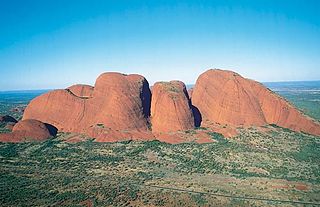
Kata Tjuṯa, also known as The Olgas and officially gazetted as Kata Tjuta / Mount Olga, is a group of large, domed rock formations or bornhardts located about 360 km (220 mi) southwest of Alice Springs, in the southern part of the Northern Territory, central Australia. Uluṟu / Ayers Rock, located 25 km (16 mi) to the east, and Kata Tjuṯa / The Olgas form the two major landmarks within the Uluṟu-Kata Tjuṯa National Park. The park is considered sacred to the Aboriginal people of Australia.
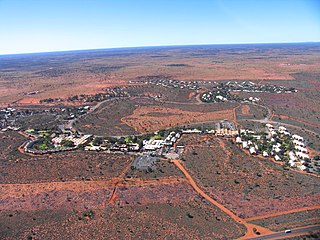
Yulara is a town in the southern region of the Northern Territory, Australia. It lies as an unincorporated enclave within MacDonnell Region. At the 2016 census, Yulara had a permanent population of 1,099, in an area of 103.33 square kilometres (39.90 sq mi). It is 18 kilometres (11 mi) by road from World Heritage Site Uluru and 55 kilometres (34 mi) from Kata Tjuta. It is located in the Northern Territory electorate of Gwoja and the federal electorate of Lingiari.

The Pitjantjatjara are an Aboriginal people of the Central Australian desert near Uluru. They are closely related to the Yankunytjatjara and Ngaanyatjarra and their languages are, to a large extent, mutually intelligible.
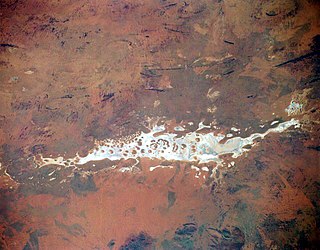
Lake Amadeus is a large salt lake in the southwest corner of Northern Territory of Australia, about 50 kilometres (31 mi) north of Uluru. The smaller Lake Neale is adjacent to the northwest. It is part of the Amadeus Basin that was filled with the erosion products of the Petermann Orogeny.

Mutitjulu is an Aboriginal Australian community in the Northern Territory of Australia located at the eastern end of Uluṟu. It is named after a knee-shaped water-filled rock hole at the base of Uluṟu, and is located in the Uluṟu-Kata Tjuṯa National Park. Its people are traditional owners and joint managers of the park with Parks Australia. At the 2011 census, Mutitjulu had a population of 296, of which 218 (71.2%) were Aboriginal.

The Petermann Orogeny was an Australian intracontinental event that affected basement rocks of the northern Musgrave Province and Ediacaran (Proterozoic) sediments of the (now) southern Amadeus Basin between ~550-535 Ma. The remains are seen today in the Petermann Ranges.

The Great Central Road is a mostly unsealed Australian outback highway that runs 1,126 km (700 mi) from Laverton, Western Australia to Yulara, Northern Territory. It passes through a number of small communities on the way.

Curtin Springs, formerly Mount Conner Station, is a pastoral lease operating as a cattle station in the Alice Springs region of the Northern Territory of Australia.
The Petermann Ranges are a mountain range in central Australia. They run 320 km (200 mi) across the border between Western Australia and the southwest corner of the Northern Territory.
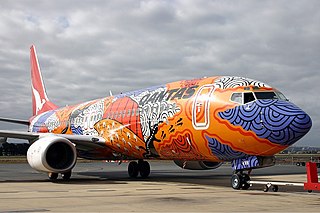
Rene Kulitja, also known as Wanuny Kulitja, is an Aboriginal Australian artist. She works with a range of media, including paint, glass and ceramics. Her most famous design is probably Yananyi Dreaming, which covers a Qantas Boeing 737.
The Kelly Hills are a mountain range at the southern end of the Northern Territory of Australia. It is located in the locality of Petermann directly north of the Musgrave Ranges and about 50 kilometres (31 mi) northeast of Amaṯa in South Australia. Its highest point is about 870 metres (2,850 ft) above sea level. Mount Robert, at the eastern end of the range, is about 796 metres (2,612 ft) above sea level. The area is known as Aputjilpinya in the native Yankunytjatjara language. It forms part of an important Mala Dreaming track that runs between Uluṟu and Ulkiya.
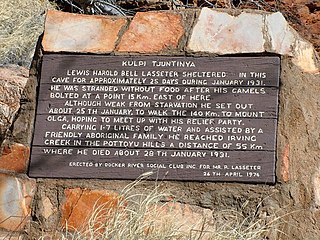

Vincent Forrester is an Aboriginal Australian activist, artist and community leader. Forrester was a founding member of a number of Aboriginal organisations in central Australia. He lives at Mutitjulu, where he has served as the chairman of the community council. During the 1980s, he served as an advisor on indigenous affairs to the governments of Malcolm Fraser and Bob Hawke.
Malya Teamay is an Aboriginal Australian artist. He is also an administrator of Uluṟu-Kata Tjuṯa National Park, serving as a member of its Board of Management. As an artist, Teamay works for Walkatjara Art Uluṟu. This art centre is part of the Uluṟu–Kata Tjuṯa Cultural Centre located inside the national park. Examples of Teamay's paintings are held in the Queensland Gallery of Modern Art, and the Museum of Victoria.
Petermann is a locality in the Northern Territory of Australia located about 1,427 kilometres (887 mi) south of the territory capital of Darwin in the territory’s south-western corner adjoining the states of South Australia and Western Australia.

The Red Centre Way is a scenic route with a total length of 835 km, consisting of roads named Namatjira Drive, Luritja Road, Larapinta Drive and parts of the Lasseter Highway. Beginning in the city of Alice Springs, it connects the villages of Hermannsburg and Yulara, the Watarrka, West MacDonnell, Fink Gorge and Uluṟu-Kata Tjuṯa National Park, nature reserves such as Tnorala and Alice Springs Desert Park, and deserts, mountain ranges and many other unique tourist attractions.
References
- ↑ "Localities within the Petermann-Simpson sub-region (CP 5080)". NT Place Names Register. Northern Territory Government. Retrieved 20 January 2020.
- ↑ Robert Layton (1986), Uluru: an Aboriginal history of Ayers Rock, Australian Institute of Aboriginal Studies, p. 124, ISBN 9780855751616
- ↑ John Toohey (1980). "Report by the Aboriginal Land Commissioner, Mr Justice Toohey, to the Minister for Aboriginal Affairs and to the Minister for Home Affairs". Uluru (Ayers Rock) National Park and Lake Amadeus/Luritja Land Claim. Canberra: Australian Government Publishing Service. p. 15. ISBN 0-642-046-255.
- ↑ "Uluṟu-Kata Tjuṯa National Park Notes: Non-Aboriginal history". Parks Australia and the Muṯitjulu Community. 19 October 2001.
- 1 2 Dawn Chatty; Marcus Colchester (2002), Conservation and mobile indigenous peoples: displacement, forced settlement, and sustainable development, Berghahn Books, p. 366–367, ISBN 9781571818416
- ↑ Margo Neale; Sylvia Kleinert; Robyne Bancroft (2000). The Oxford companion to aboriginal art and culture. Oxford University Press. p. 54. ISBN 9780195506495.
- 1 2 Paul Burke (2011). Law's Anthropology: From Ethnography to Expert Testimony in Native Title. Canberra: Australian National University. pp. 243–244. ISBN 9781921862434.
- ↑ Uluru–Kata Tjuta National Park: Knowledge Handbook (pdf), Australian Government, Director of National Parks, 2009
- ↑ Nina Collins (12 June 2002). "Uluru – Kata Tjuta Aboriginal Land Trust". Agreements, Treaties and Negotiated Settlements Project. Melbourne: Indigenous Studies Program, University of Melbourne. Archived from the original on 24 January 2013. Retrieved 15 April 2013.